Fujian cuisine master crafts feast from 20-kilogram wild grouper in Pingtan
en.ptnet.cn | Updated:2025-09-18 | Lin Kongbo, Stephanie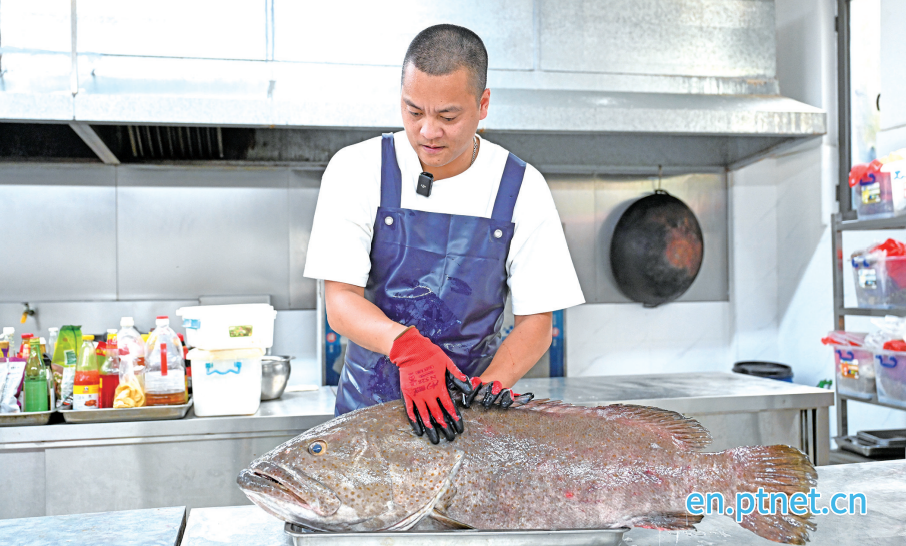
Shi Kunhua prepares to handle thegiant wild grouper.
Pingtan, a coastal county in southeast China's Fujian Province, stands as the Chinese mainland's closest point to Taiwan and the country's second international tourism island after Hainan. Beyond its role as a pilot zone for cross-Straits integration, the island is celebrated for its maritime culture—especially its time-honored traditions of seafood cuisine, shaped by generations of "living off the sea." Recently, this culinary heritage took center stage when renowned Fujian cuisine master Shi Kunhua turned a massive wild grouper, a gift from a friend's fishing trip, into a multi-course feast that blended local flavors with regional culinary influences.
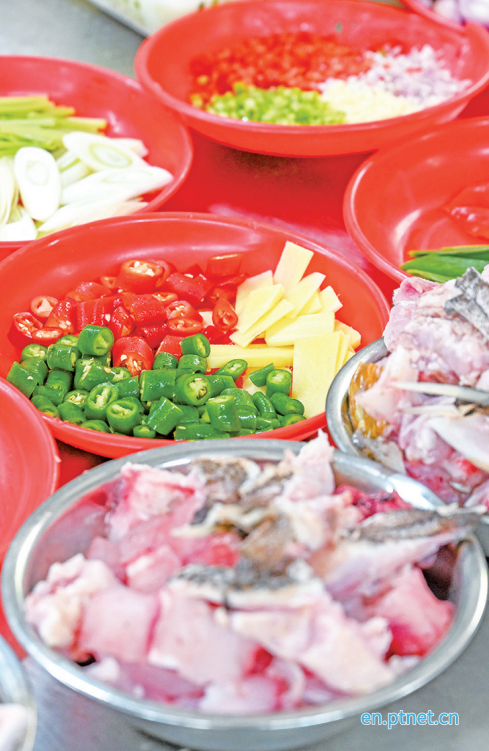
A vibrant assortment of aromatic ingredients (for seasoning and stir-frying)
The star ingredient of the feast was no ordinary fish: a wild grouper, locally known as "Mao Zai Gui" or "Hua Ban," weighing around 20 kilograms (44 pounds) and measuring 1.1 meters (3.6 feet) long. For Shi, assessing the fish's freshness was second nature, relying on Pingtan's traditional methods. "You check the gills first—bright red means it's fresh, no exceptions," he explained, gesturing to the fish's vibrant gill tissue. "Then run your hand over the body: it should be smooth, firm, and free of scratches. This one was a rare find."
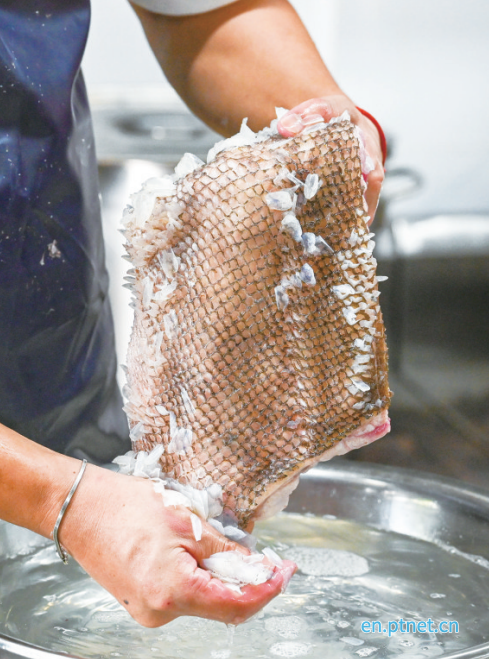
After blanching the fish skin in boiling water, the scales peel off easily
In a bright kitchen workshop, Shi demonstrated meticulous fish preparation, drawing curious onlookers as he worked. He started by removing the grouper's gills with precise knife strokes, then used a combination of a cleaver and scissors to detach the large head—revealing tender underbelly meat in the process. When he sliced open the fish's belly, he made a pleasant surprise discovery: a fresh octopus hidden inside. Finally, he split the fish's body along its bones, exposing pearlescent white flesh with faint red veins—a sign of exceptional quality.
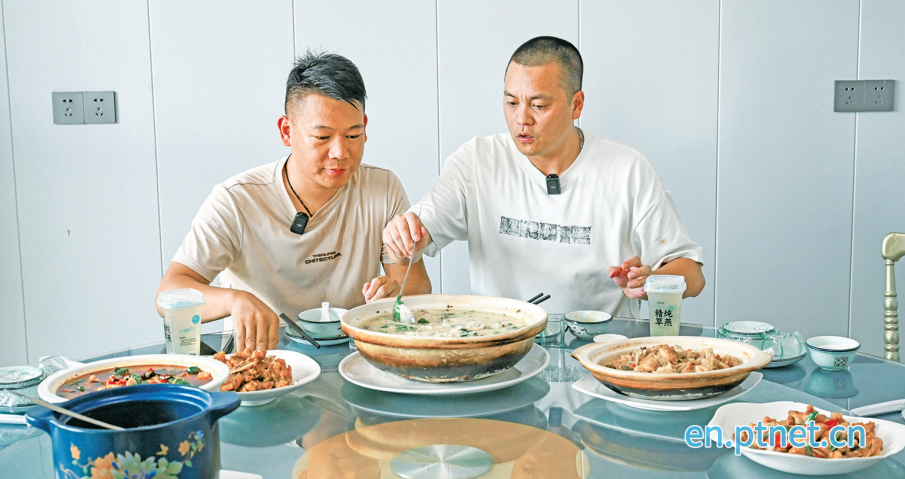
Shi Kunhua (right) and his good friend Wei Youhong enjoy the whole-grouper feast together.
"Pingtan people never waste a single part of a fish," Shi said, explaining the philosophy behind his cooking. "The meat can be sliced for sashimi, the belly for braising, and even the skin for congee." True to this "zero-waste" ethos of using every ingredient to its full potential, he crafted a feast that honored local traditions while incorporating flavors from Guangdong and Sichuan provinces—each dish turning a different part of the grouper into a standout delight.
Standout Dishes: From Belly to Bones, No Part Wasted
Cantonese-Style Braised Fish Belly (5/5 Rating)
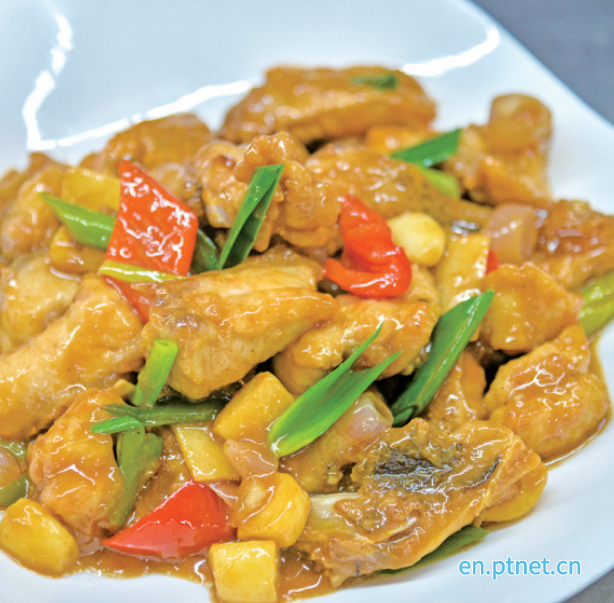
Braised grouper belly (Cantonese-style)
A classic example of Shi's "one fish, multiple dishes" approach, the braised fish belly merged Pingtan's home-style cooking with the delicate techniques of Cantonese cuisine—making it one of Shi's signature dishes. The key to its success, Shi emphasized, was keeping the fish belly "tender to the point of melting in the mouth."
First, he marinated the fish belly in egg yolk, salt, monosodium glutamate (MSG), and white pepper. "The egg yolk doesn't just boost umami—it coats the fish, locking in moisture so the inside stays juicy even after frying," he explained. After five minutes of marinating, the fish belly went into hot oil, frying until its outer layer turned golden and crisp, while the inside remained soft.
Next, Shi heated a new wok, stir-frying aromatics like ginger and garlic until fragrant, then added soy sauce and other seasonings to create a rich sauce. He gently added the fried fish belly, flipping it carefully to coat it in the sauce, and simmered over low heat to let the meat absorb every drop of flavor. The result? Fish belly that was tender but not mushy, with a deep, savory taste layered with hints of sweetness. "We can't abandon our traditions, but we also need to add new ideas," Shi said of the fusion style. "That's what makes this dish unforgettable."
Fish Skin Congee (5/5 Rating)
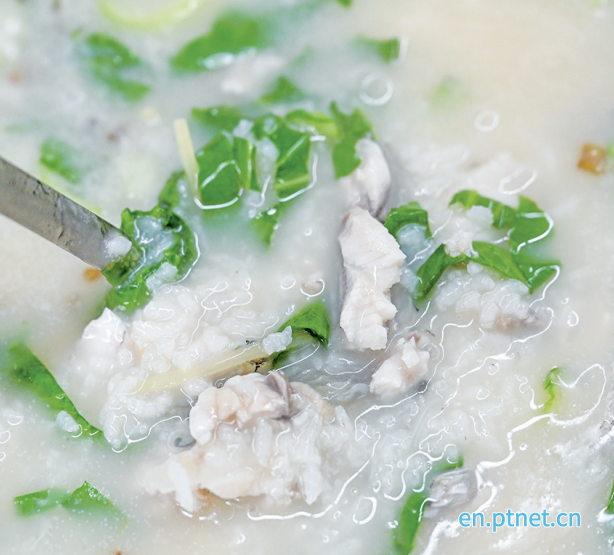
Creamy fish skin congee
For many Pingtan locals, a bowl of fish skin congee is a beloved breakfast memory—and Shi's version turned the often-overlooked fish skin into a delicacy, staying true to the "no waste" principle. He used the skin left after filleting the fish belly, cleaning it thoroughly and cutting it into thin strips.
The cooking process was simple but required patience. Shi first simmered dried scallops and shredded ginger in a clay pot to build a savory base, then added raw rice and water. The critical step, he noted, was timing: "Add the fish skin only when the rice just starts to bloom. Simmer on low heat so the collagen from the fish skin slowly melts into the congee."
No extra seasonings were needed— the natural sweetness of the fish skin and the umami from the dried scallops were enough. The final congee was smooth and creamy, with the fish skin adding a subtle texture and a fresh, oceanic flavor. "A bowl of congee like this is a taste of the sea," Shi said. "This is what Pingtan people mean by 'original flavor'—letting the ingredients speak for themselves."
Fish Bone Soup (5/5 Rating)
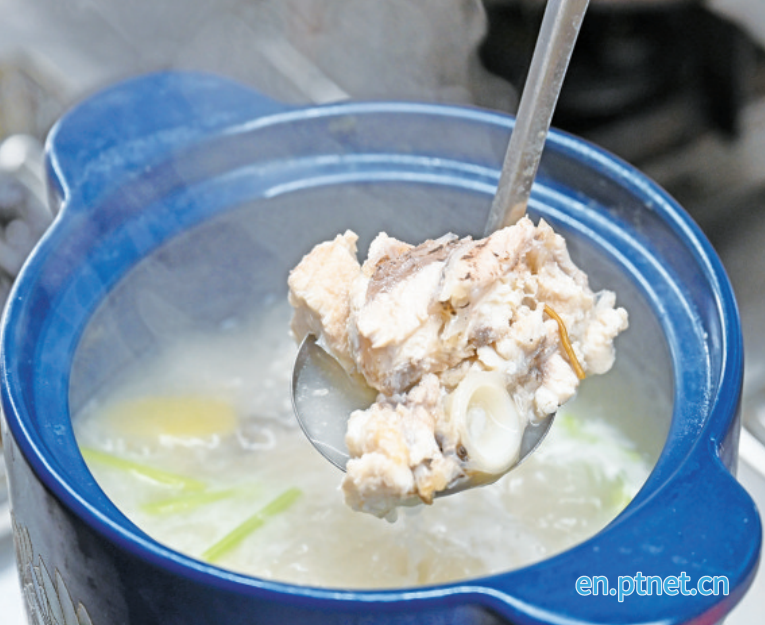
Milky-white grouper bone soup
To wrap up the feast on a warm note, Shi prepared a milky white fish bone soup—using the grouper's central bones, a part many might discard, but which he turned into a comforting, nourishing dish. "In Pingtan, eating fish is as common as eating rice," Shi said. "This soup isn't just food—it's a way to hold onto our feelings for home."
The secret to the soup's creamy white color was simple but crucial: he first fried the cleaned, dried fish bones in hot oil until both sides turned golden. Then, he poured in boiling water—"the sudden heat is what makes the soup turn milky," he explained. He let the soup boil vigorously, leaving the thin layer of foam on top, as "that's where the freshness and color come from."
Once the soup was ready, Shi added local seafood like shrimp or clams to boost the flavor, then sprinkled with chopped green onions and white pepper. The result was a rich, smooth soup with a pronounced seafood aroma that warmed both body and heart.
Other Highlights
Crispy salt-and-pepper grouper tail
Cantonese-style braised grouper head in clay pot
Sichuan-style boiled grouper slices
The feast also included crowd favorites like Cantonese-style fish head hot pot: Shi sautéed ginger, garlic, and green onions in a clay pot (reminding his apprentice, "Don't use too much heat—let the aromatics release slowly") before adding the grouper head and simmering until the meat was fall-off-the-bone tender, with a golden, gelatinous broth. For a crispy option, he fried the grouper's tail in oil until it turned golden, creating a spicy salt fish tail that guest Wei Youhong praised: "It's crispy on the outside and tender inside—perfectly seasoned." He also prepared Sichuan-style boiled fish, blanching thin slices of grouper in a spicy broth before pouring hot oil over dried chili peppers and Sichuan peppercorns—resulting in a dish that balanced the fish's natural sweetness with bold, numbing heat.
As diners gathered around the table to sample the meal, the room filled with the aroma of fresh seafood and spices. For Shi, the feast was more than just a display of culinary skill—it was a tribute to Pingtan's maritime roots. "Every time I prepare fish, I think of my childhood, waiting by the wood-fired stove for my elders to make fish soup," he said. "That milky white soup is something all Pingtan people remember. The sea gives us so much, and this is my way of honoring that gift."

 Fujian Public Security Registration Code: 35012802000271
Fujian Public Security Registration Code: 35012802000271